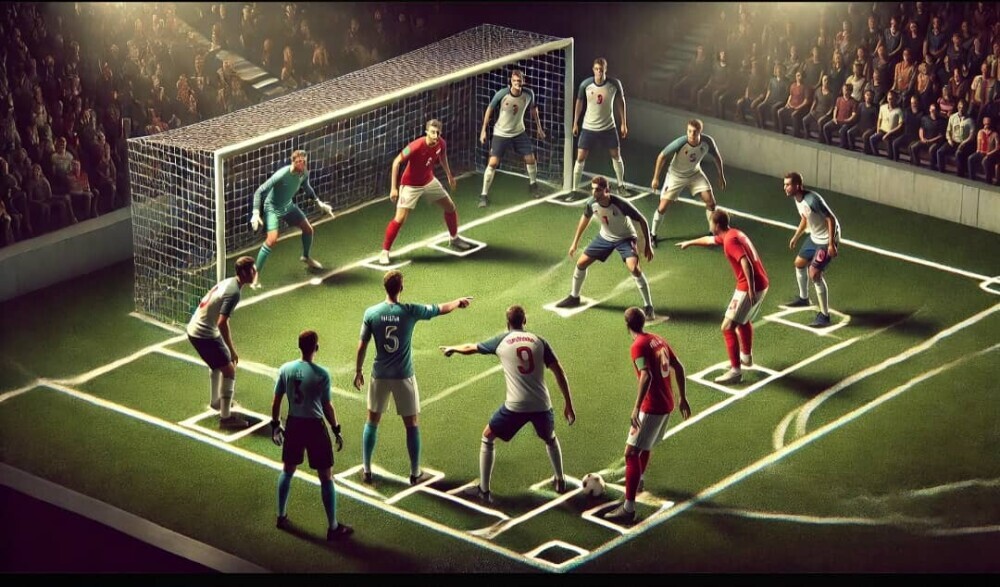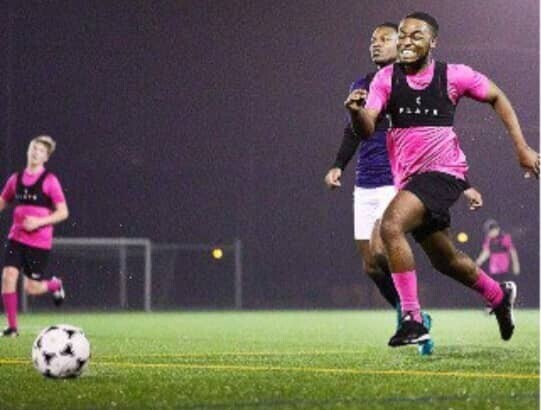Zonal marking might sound a bit fancy, but it’s pretty straightforward once you break it down.
It’s a defensive strategy where each player is responsible for an area, not a specific opponent. This system requires players to rely on awareness rather than chasing down players all across the field.
So, why bother with zonal marking when man-to-man marking exists? Well, imagine chasing someone around for 90 minutes.
Exhausting, right?
Zonal marking helps conserve energy by having players stay put within their zones unless they need to challenge an intruder. It’s about working smarter, not harder.
Zonal marking isn’t a blanket solution for every defensive line-up, though. Coaches often blend it into their strategies to make it harder for opponents to find gaps. Defenders become tactical chess pieces, moving in sync to block attacking runs and passes.
Choosing zonal marking offers some neat benefits, like improving team cohesion and reducing the risk of defensive gaps when done right.
However, the flip side is also there. Miscommunications can lead to disastrous defensive collapses, so it demands sharp focus and teamwork.
Incorporating zonal marking requires each defender to know their space like the back of their hand. It involves a mental map of who covers which area and consistently scanning the field for threats.
Success here hinges on communication and a clear understanding of each other’s roles.
Framework of Zonal Marking: Roles and Responsibilities
In the zonal marking system, it’s all about defining who does what and where. Imagine each defender having their little patch of grass that they need to protect. This approach relies on understanding spaces rather than always focusing on opponents.
The key aspect of zoning involves precise role allocation.
Center-backs anchor the defense, often taking responsibility for the central zones where the highest threat level lies.
Full-backs, on the other hand, are in charge of flanking zones, keeping an eye on wingers attempting to break wide open.
Midfielders chip in, covering pockets just in front to support the backline.
A smooth-functioning zonal marking line is like a symphony. Communication plays a big role here.
Defenders must be chatty, calling out threats, and ensuring there’s no confusion over who guards what space.
It’s essential to keep talking, especially during those intense moments when an opponent is charging towards the goal.
Adapting when opponents tweak their strategy is critical too. One minute, defenders might be dealing with a two-man attack; the next, they need to adjust to a full-blown offense. This adaptability is what sets sharp defenders apart.
Zonal marking asks defenders to pay attention to the bigger picture. This means not just sticking to their spots but also supporting their teammates when the game’s dynamic shifts. It’s all about maintaining awareness and sticking together as a unit.
Implementing Zonal Marking in Practice
Getting zonal marking to work on the field takes more than just knowing your zones—it’s all about practice and rehearsal.
Picture this: equipping your team with football GPS and turning every defender into a zonal artist. Yeah, it’s like tapping into a technique rather than just skill.
Training drills become your best friends here. Start with exercises that boost awareness, where defenders practice holding their positions while scanning incoming threats.
It’s all about honing instincts and snapping into action when your area comes under siege.
One-to-one feedback is gold. After training sessions, sit down with each player to review what went right and where improvements are needed.
Using game footage to show examples can provide invaluable learning moments.
Drills like shadow covering or shifting blocks help defenders experience actual match scenarios without the pressure of a competitive game.
It’s about repetition until reacting correctly to an attack becomes second nature.
Reflecting on past matches provides insights too. Analyzing what went down in a game gives defenders a chance to polish their approach.
This way, when match day rolls around, your squad is locked, loaded, and zonally savvy.
Analyzing Opponents: Tactical Intelligence in Zonal Marking
Getting inside the opponent’s head is crucial for any defender using zonal marking. It’s like detective work—studying how opponents love to play and countering their favorite moves before they even think about them.
Start by diving into match footage of your latest or next opponent. Look at how their key players make runs and the patterns they use when attacking.
This kind of tactical awareness helps defenders anticipate movements and keep their zones secure.
Identifying critical threats is part of the strategy. Maybe they have a forward who drifts wide or a midfielder who likes to sneak into pockets of space.
Knowing this in advance allows defenders to adjust their zones slightly or communicate better to close gaps before they appear.
Keeping in mind how opponents line up and thinking a step ahead is key. Awareness of their shape on the pitch prepares defenders to adapt their zonal framework accordingly.
Sometimes it means slightly narrowing or widening the protective area to deny them opportunities.
Utilizing video analysis tools can be an eye-opener. This technology provides defenders with visual data to enhance understanding and strategize an effective response.
It’s like seeing the game from a bird’s-eye view, spotting patterns, and making informed decisions.
Case Studies: Successful Zonal Marking in Professional Soccer
Digging into some well-known games can shine a light on how effective zonal marking can be in action. Professional teams often tweak their strategies, providing us with a masterclass in the art of zoning.
Take, for instance, the 2020 UEFA Champions League quarter-final match between Atalanta and Paris Saint-Germain (PSG).
In this high-stakes encounter, Atalanta’s defenders employed a near-perfect zonal marking system, especially during PSG’s attacking set pieces.
The defenders maintained their zones with eyes like hawks, cutting off every passing lane and frustrating the attackers to no end.
They forced PSG into making rushed decisions, often passing sideways or backward when trying to break down Atalanta’s defensive shape.
Such performances often involve analyzing clubs that perfected zoning, like Atalanta, a team known for its disciplined backline.
These sides aren’t just blocking spaces; they’re dictating play without even touching the ball. In the PSG match, Atalanta’s defenders showed that good zonal marking is about intelligence over aggression.
They didn’t go chasing the ball; instead, they forced PSG to play into their well-organized zones, limiting their attacking opportunities.
In contrast, in the 2019 Champions League final between Liverpool and Tottenham Hotspur, Liverpool’s zonal marking was put to the test but didn’t always go according to plan.
Early on, Tottenham had a few chances where Liverpool’s defenders lost focus, allowing Spurs to exploit pockets of space.
While Liverpool eventually won, their shaky moments of defending set pieces demonstrated the risks of static zonal marking—without proper vigilance, defenders can become passive and allow attackers to capitalize on small lapses.
Spotlighting matches where zonal marking didn’t go as planned can also be enlightening. Stuff happens, and reviewing these instances can teach defenders what to avoid, whether it’s being caught static or losing focus at crucial moments.
Insights from seasoned defenders reveal the tweaks and real-time decisions that go unrecorded yet often decide matches.
They share wisdom on maintaining patience and control, emphasizing that good zonal marking is dynamic, not static.
Improving Defensive Skills: Challenges and Solutions within Zonal Marking
Mastering zonal marking isn’t without its bumps.
Common pitfalls include losing track of opposing players or being caught in two minds about which threat to prioritize. Awareness must remain on high alert to avoid such splits in focus.
Commitment to better communication can’t be stressed enough.
Everyone on the line should be vocal, shouting out movements and passing information continuously. It’s about building a wall of words as much as bodies.
In high-pressure moments, staying cool is paramount. Panic is the enemy of a well-executed zone.
Developing mental resilience through simulated stress drills in training can help defenders remain calm when the stakes are high.
Keeping pace with the evolving nature of soccer tactics is essential. As coaches invent new attacking trends, defenders need constant adaptation.
Continuous learning and updates on the latest tactical shifts will ensure that no one gets left behind in the zonal marking game.
Above all, enhancing reaction times and spatial awareness through targeted exercises helps defenders remain proactive rather than reactive.
Encouraging defenders to trust their instincts while sticking to their zones results in them feeling more comfortable, confident, and in control.
Conclusion
Mastering zonal marking is a game-changer for soccer defenders. By understanding the framework, roles, and responsibilities, defenders can protect their team’s goal and outsmart opponents. With practice, analysis, and teamwork, zonal marking can become a powerful tool in your defensive arsenal.
Call to Action
Ready to take your defensive skills to the next level? Check out our recommended resources for soccer defenders, including training drills, tactical analysis tools, and performance-enhancing gear. Click the links below to learn more and improve your game:
Happy soccer season!!!!!!
Here’s a little transparency: Our website contains Amazon affiliate links. This means if you click and make a purchase, we may receive a small commission. Don’t worry, there’s no extra cost to you. It’s a simple way you can support our mission to bring you quality content.”





As a mom whose teenage son plays soccer, I’m always eager to understand the game’s tactics better to support his development. This guide on zonal marking was incredibly enlightening!
The explanation of how each defender is responsible for a specific zone rather than marking individual opponents helped me grasp the importance of spatial awareness and communication on the field. It’s fascinating to see how this strategy emphasizes teamwork and understanding over sheer physicality.
I especially appreciated the section on implementing zonal marking in practice. The idea of using training drills to enhance defenders’ instincts and reactions makes so much sense. I’ll definitely share these insights with my son; I believe it will help him and his teammates improve their defensive coordination.
Thank you for breaking down such a complex topic into an accessible and engaging read. It’s resources like this that make it easier for parents like me to stay involved and informed.
Hi Alyssa,
Thank you so much for your kind words—I’m truly glad you found the guide helpful! It’s always encouraging to hear from parents who are eager to understand the game and support their kids in a meaningful way.
That involvement can make a big difference, especially during the teenage years when players are developing both technically and tactically.
You’re absolutely right—zonal marking is all about teamwork, spatial awareness, and anticipation.
Once young players start to grasp how it works, it really elevates their defensive discipline and overall understanding of the game.
It’s great to hear you’re sharing these insights with your son—chances are, he and his teammates will start to see real improvements in their coordination and decision-making on the pitch.
If you or your son ever have questions about specific drills or want help adapting any exercises to a team setting, feel free to reach out. I’m always happy to provide a few extra ideas or pointers.
Thanks again for taking the time to read and comment.
Wishing your son all the best in his soccer journey!
Raymond